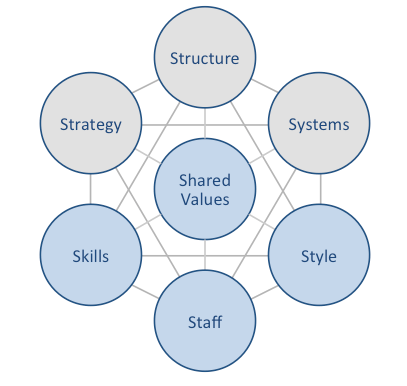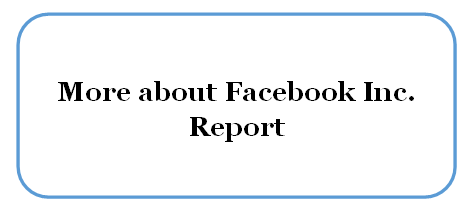Facebook McKinsey 7S Model: Benefiting from Shared Values
Facebook McKinsey 7S framework illustrates how seven individual elements of businesses can be aligned to increase effectiveness. According to McKinsey 7S model, structure and systems represent hard elements, whereas shared values, skills, style and staff are soft elements. The framework stresses the presence of strong links between elements in a way that a change in one element causes changes in others. As it is illustrated in figure below, shared values are positioned at the core of Facebook McKinsey 7S framework, since shared values guide employee behaviour with implications in their performance.
Facebook McKinsey 7S Framework
Hard Elements
Strategy. Facebook follows cost leadership business strategy with a particular focus on user experience. According to its mantra “1% is finished”, the social media company develops new products and services and improves its current range of products and services in a continuous manner. Additionally, important elements of Facebook Inc. business strategy include growth via acquisitions and continuous exploration of new ways of site monetization with positive implications for the bottom line.
Structure. Facebook Inc. has a hybrid organizational structure that integrates important elements of hierarchical and divisional organizational structures. Elements of hierarchical structure are expressed via presence of multiple levels of management in the company, whereas elements of divisional or matrix organisational structure are evident on the formation of product-based teams on the global scale. The founder, Chairman of the Board and CEO Mark Zuckerberg is the main driving force and the ultimate operational and strategic decision maker in the company.
Systems. Facebook Inc. business operations rely on a wide range of organizational systems. The ranges of systems that are the most critical for the social media company include HR system, information system, security system and others. Security system in particular is a critical success factor and it relates to both, company’s own security, as well as, the security of users of the social media site. The company has a control system in place to ensure its own security against hacks and the security of its users against the loss of their personal data and a wide range of other threats to their financial, emotional and physical well-being…
Facebook Inc. Report contains a detailed discussion of Facebook McKinsey 7S framework. The report also illustrates the application of the major analytical strategic frameworks in business studies such as SWOT, PESTEL, Porter’s Five Forces, Value Chain analysis and on Facebook Inc. Moreover, the report contains analysis of Facebook’s marketing strategy, leadership and organizational structure and discusses the issues of corporate social responsibility.


